
Gary Inman and Zach Hodgin anticipate
a post-pandemic
flood of designs focusing on new materials and
colors. Get ready for less beige
and boring and a number of hard-to-
reconcile, diverse design trends.
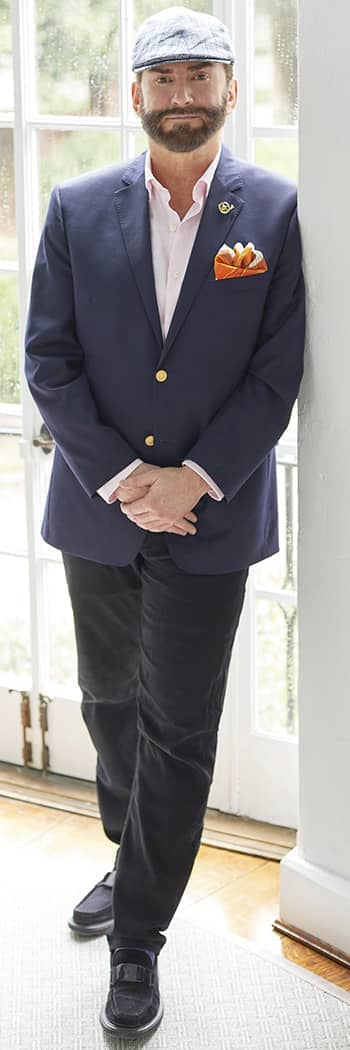
Gary Inman, founder,
Gary Inman Home Couture
|
Back in 2016, Furniture World interviewed Gary Inman for a wide-ranging article on interior and product design. Inman’s advanced studies in fashion, textile and costume history, as well as art history and architectural history, inform his work as a furniture and interior designer, author, educator and lecturer. He is sought out for his expertise in commercial, residential and product design.
After recently leaving his position as Vice President of Hospitality with the iconic commercial design firm Baskervill, Inman decided to move from Richmond, Virginia, to High Point. There he will pursue teaching as well as the practice of interior design at the company he founded in 1998, Gary Inman Home Couture. Inman, along with his associates Dani Blake and Zach Hodgin brainstormed a new interior design business model.
“I had worked with designer Dani Blake for a number of years at Baskervill imagining luxury projects,” Inman told Furniture World. “After we left Baskervill, an idea emerged for a business model to bring together a group of like-minded synergistic firms in creative alliances.”
As we move into a
period characterized by a renewal of hope and energy, the color green will be favored, including earthy sage, pistachio and leafy greens.
|
Zach Hodgin who was also interviewed for this article is an interior designer who grew up styling wholesale showrooms in High Point, before earning his Interior design degree at UNCG. After college he took a job in home staging and then moved on to working on the retail side of interior design. Said Inman, “One of the reasons I wanted Zach on my team is that he has experienced the manufacturing side as a visual merchandiser, most recently joining the team that created the buzzworthy Gabby Home showroom In High Point. He’s also experienced on the retail side, and now on the full-service interior design side as well.
“Zach and I became friends due to our shared interests in historical period styles and new traditionalism. He’s an excellent renderer,” added Inman, noting the upcoming exhibit, “The Eye and The Hand” at the Bienenstock Furniture Library during the fall High Point market that will feature Hodgin’s renderings. “Although he’s 30 years my junior we developed a surprising camaraderie.”
Design in the Age of COVID
“During the pandemic,” Hodgin observed, “people are making their homes better and cozier. It’s crazy to see the number of people who are buying furniture right now. They are looking for adaptable spaces suitable for living and working. Everyone in our industry has seen a spike in home office and outdoor furniture sales.”
“There has also been a huge paradigm shift during the pandemic,” noted Inman. “A change in the way people want to live their lives has affected how they purchase home furnishings. COVID has been the elephant in the room, so to speak. A new zeitgeist has emerged, much like there was during the art deco period, the jazz age, or the machine age.
New Focus on Materials
Hodgin has noticed that consumers have developed a heightened interest in how things are made and what they’re made of. “They are asking what chemicals are in home furnishings products and what types of VOC emissions they produce.”
“We’ve seen shifts in materials usage associated with this,” added Inman. There’s been a big uptick in copper and zinc being used by manufacturers for their anti-microbial and anti-viral properties. The outdoor furniture company Vondom is using an extruded shaped resin that is anti-microbial and anti-viral, as well. We will see more introductions incorporating these kinds of materials at upcoming High Point shows.
“There’s been a lot of talk about healthy lighting, vegan leather products, fragrances and the type of fibers used in bedding. We’re seeing a lot more interest in organic materials such as linen, bamboo, cork and wool. People are looking for ways to heal themselves, to be healthier, and build a sense of serenity in a period that’s been disrupted by the pandemic and politics.
“Younger industrial and product designers are working to nudge the furniture industry to be more responsible. They have a desire to do the right thing and are finding ways to do that through better design. This addresses an increasing agitation among consumers regarding the degradation of the planet. Their concern is generating a longer-term shift away from a mindset of purchasing lower quality furniture that’s available immediately and is likely to end up in a landfill. Consumers are increasingly educated and empowered regarding sustainability principles. They are demanding beautiful and responsible design options from manufacturers and designers in both the residential and commercial sectors.”
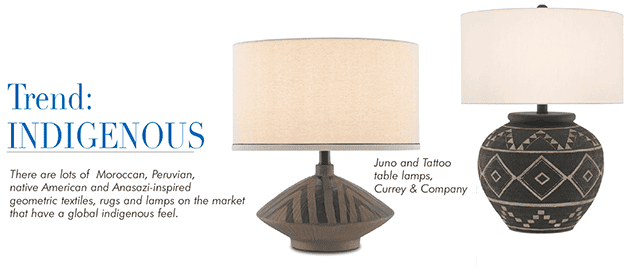
A Clogged Product Pipeline
“Furnishings products that were in the pipeline for the spring High Point show in 2020 didn’t get shown,” noted Inman. “The entire cycle of introducing products got shut down so we aren’t going to see much that’s new until October at the earliest.”

Zach Hodgin,
Gary Inman Home Couture
|
When introductions start flowing once again he predicts a torrent. “We’re going to see lots of innovative design introductions in both residential as well as on the hospitality side. My colleagues who haven’t been that busy this past year have a lot of bottled-up design passion for creating healthy spaces. Part of that will be a fundamental shift in the way that we think about lighting. It isn’t going to be just about illuminating a room. Lighting design will be approached increasingly from the perspective of neuroscience, taking into account how the human brain works and how lighting impacts our sleep, productivity, emotions and overall health.”
Trend: Less Boring & Beige
After the privations that came along with the First World War and the pandemic of 1918-1919, a desire for better, brighter and more colorful lifestyles emerged. Likewise said Inman, “Coco Chanel said that after having lived through the austerity of World War II, people had a desire to embrace decadence. I feel like we are having that kind of moment now. They have been bottled up, held down and isolated. And when the door opens, it’s going to blast open. People are going to travel; hotels will renovate and freshen up.”
Hodgin agreed, and as evidence pointed out an art deco design revival. “That includes organic materials, bold patterns, colors and metal geometrics. The design has been updated with the bold purples and greens, ochre and mustard colors people are wild about right now.”
“It’s a different kind of aesthetic,” added Inman. “What we’re seeing with art deco is an energy shift that ties into a current design environment that emphasizes bold patterns, bigger scaled textiles and prints. People are looking for excitement. They want their spaces to be more dramatic and have grown tired of looking at mid-century furnishings. Mid-century won’t totally disappear, but taking its place will be art deco design. The work of my friend, the Australian designer Greg Natale (www.gregnatale.com) comes to mind. He’s an incredible designer whose work channels the energy of Paris in 1920 or a chic London boutique hotel circa 1918.
“The design community is aching to get away from so much boring beige and grey. It will be replaced in part by a strong trend toward using simple deco-inspired geometric forms, but also curves. Home furnishings product designers are incorporating radius curves everywhere. Historically it was called streamlining. Curvaceous sitting pieces are a big part of art deco. It’s a trend that Style Spotters have seen building over the past two High Point markets.”
The Luxury Mindset
“On the fashion front, energy and passion are emerging. It has a celebratory feel, like there’s a party going on. And right now,” Hodgin said, “in fashion, we are seeing, linens and flowing women’s dresses that are free and floral. Whenever people have been cooped up and feel deprived they want to experience extravagance, decadence and deliciousness.

“There’s also a new trend that has been embraced by younger home furnishing customers called Grandmillennial or Granny Chic. It’s associated with nostalgic chintzy upholstery, updated needlepoint cushions, tassels, florals and elements of classic design from a previous generation.
“They’re buying on Esty,” he said, “as well as finding items at consignment shops or antiques malls. Beautifully ornamented and period styles are used to create a fresh, new, personalized and eclectic style that’s luxurious in its own way. They might take a chest found in their grandmother’s home, and place a modern lamp on top.”
“Then maybe put a fun shade on the lamp,” added Inman, “They’re mixing good craftsmanship with decadent ornamentation to create a kind of luxury that’s become cool.”
Earth Colors Rising
“There has been a lot less clarity in color trends due to pandemic-related fashion and design show cancellations over the past year,” observed Inman. “There’s a lot of guessing going on right now. I speculate that black and white will stay with us and we will move away from salmon, pinky colors. Blue is a color furnishings retailers can always count on to be important. It appears in cycle after cycle in different shades. For those who missed the last High Point Market, autumnal colors including cognac, orange tones, cinnabar, plus purple and a lot of green were a fresh surprise. I believe this natural color pallet is going to stick with us. As we move into a period characterized by a renewal of hope and energy the color green will be favored, including earthy sage, pistachio and leafy greens.”
Throwaway Culture’s End?
An appreciation of how furniture is made with craftsmanship and joinery details has become more explicit. This is a trend mentioned by Zach Hodgin during this interview and was explored by SCAD professor Sheila Edwards in the January/February 2021 issue of Furniture World.
“This trend also ties into the world of fashion,” Inman told Furniture World. “Sales of custom-made shoes, shirts by Ledbury, and Frye boots went through the roof as millennial customers pivoted to investing in fewer, better-quality goods. Trends often start in fashion and then move over to more substantial investment items in the furniture and accessories space. We are seeing a 180degree shift away from a throwaway culture in favor of purchasing items that are well made. Artisans who belong to the High Point-based Mill Collective exemplify this trend, creating organic, individually handcrafted furniture. Also, Mecox Gardens, a high-end company that’s the darling of New York designers, gets a huge amount of press about this. Mecox creates home furnishings that have an artisan feel. The company also creates engaging stories about the people who design their products.”
Design Schizophrenia
Inman mentioned that “There’s a strong trend towards art deco design and at the same time a huge interest in organic and crafted furnishings. The market is also full of wonderful Moroccan, Peruvian, native American and Anasazi-inspired geometric textiles, rugs and lamps. These designs have a global indigenous feel that’s inclusive and multicultural.
“It’s hard to reconcile these diverse trends. Makers are creating organic furniture using Japanese joinery techniques that emanate a Zen quality that’s healing, soothing and tranquil. People are looking to connect with nature through indigenous design but yet there’s demand for luxurious, glamorous environments. This speaks to the diversity of our customers and what they want as individuals.”
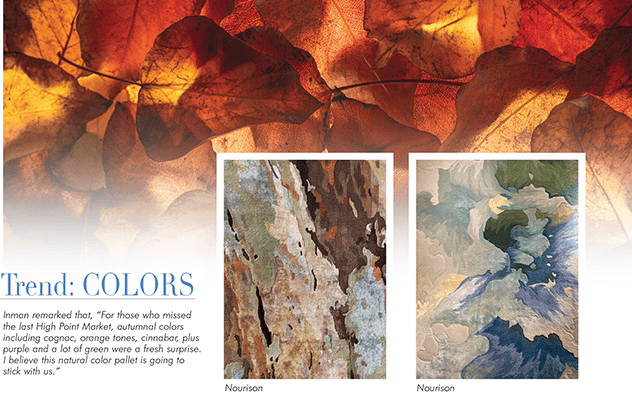
Selling to People’s Passions
My suggestion is that they should work harder to create a context in their stores to better resonate with their shoppers’ personalities. That’s much more powerful than just mixing and displaying products in a pleasing way. |
“It’s interesting to note that although we study and enjoy following trends in architecture, fashion and home furnishings design,” Inman observed, “the design work we do, ironically, isn’t about trends at all. It’s all about passion and storytelling. We believe that retailers, interior and product designers should help to create spaces filled with things people can be passionate about. These may include a mix of heirlooms, antiques and items they’ve collected on their travels. Our industry is coming off of a long period of monotonous beige. It’s exciting for us to see that the trend back toward neo-traditional design seems to be gathering momentum.
“There is a resurgence of interest in understanding the past, in traditional design methodology and aesthetics.” Inman sees an opportunity for young designers and people throughout the industry to bring depth to their design and sales presentations by becoming more familiar with the work of the great practitioners of design. People like Mark Hampton, William Haines, Billy Baldwin, Parrsh-Hadley, Mario Buatta, Dan Carithers, Dorothy Draper, Elsie de Wolfe, David Hicks—all visionary designers.
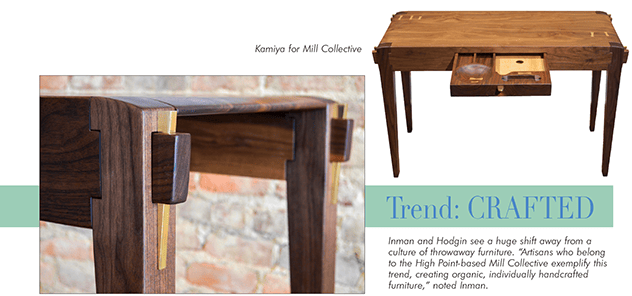
Retailing Post-COVID
Will there be a resurgence of traditional designs at brick-and-mortar retail? “If retailers don’t get more innovative,” predicted Hodgin, ”they will lose market share to alternative channels of distribution.”
Right now, retailers are focused on satisfying demand and managing their supply chains. But what will happen after that? What takeaways should retailers remember to consider post-pandemic?
Inman suggested, “It doesn’t matter if a retailer sells furnishings that embody bold decorative patterns and colors, has an indigenous feel or the hallmarks of maker culture. My suggestion is that they should work harder to create a context in their stores to better resonate with their shoppers’ personalities. That’s much more powerful than just mixing and displaying products in a pleasing way. So, if a couple walks into a store, a subset of displays they see should ideally match their personalities and lifestyles. If retailers can create that moment for them, those shoppers won’t have to visualize how an item, seen in isolation, will fit into their homes. Lots of people struggle with that. Not everyone can visualize. And this is one of the biggest opportunities for retailers and designers to collaborate.
“Finally, I would like to suggest that a source of inspiration for retailers could be Currey and Company’s High Point showroom that brings products alive through visual storytelling. Some companies have been able to do this by adding splashes of color and sometimes pattern to align product displays with compelling stories. It’s hard to translate the power of the trends we described earlier unless the furniture, accessories, lighting and rugs are all pulled together in little mini-stories that get customers excited.”
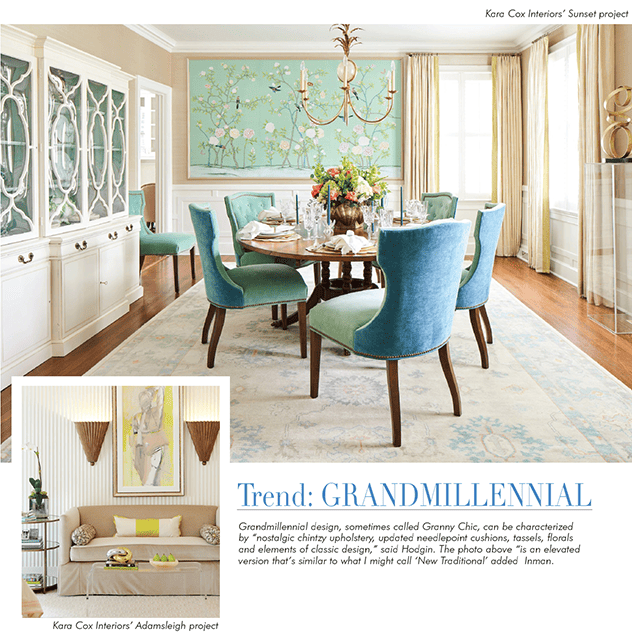
Furniture World is the oldest, continuously published trade publication in the United States. It is published for the benefit of furniture retail executives. Print circulation of 20,000 is directed primarily to furniture retailers in the US and Canada. In 1970, the magazine established and endowed the Bernice Bienenstock Furniture Library (www.furniturelibrary.com) in High Point, NC, now a public foundation containing more than 5,000 books on furniture and design dating from 1620. For more information contact editor@furninfo.com.